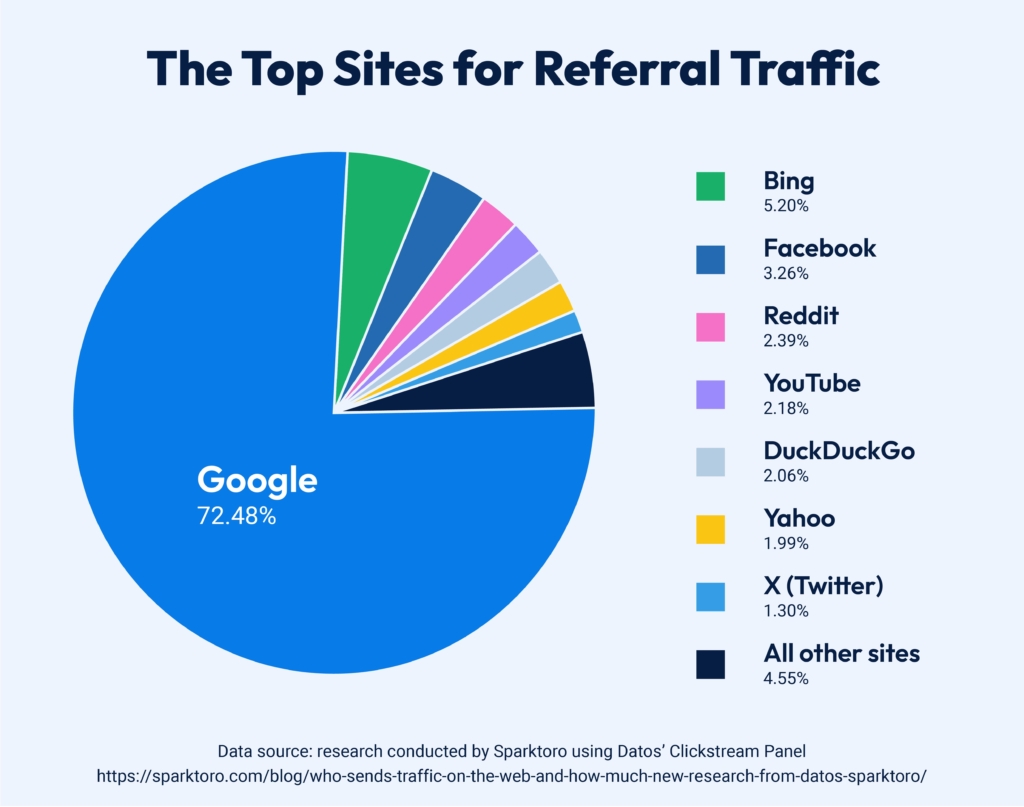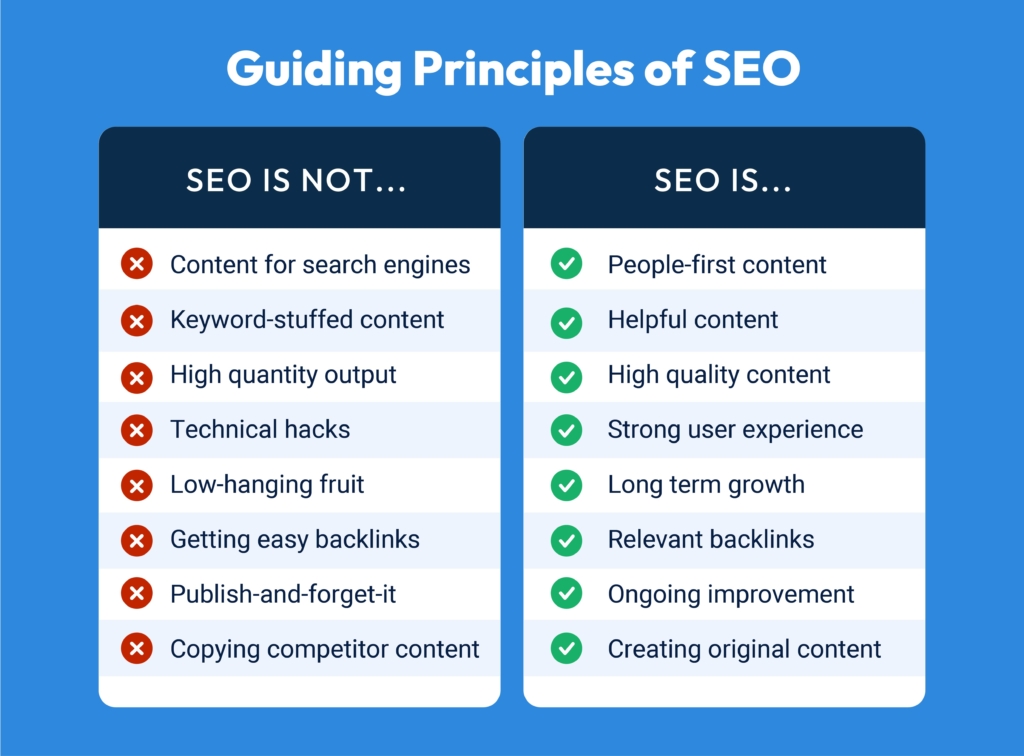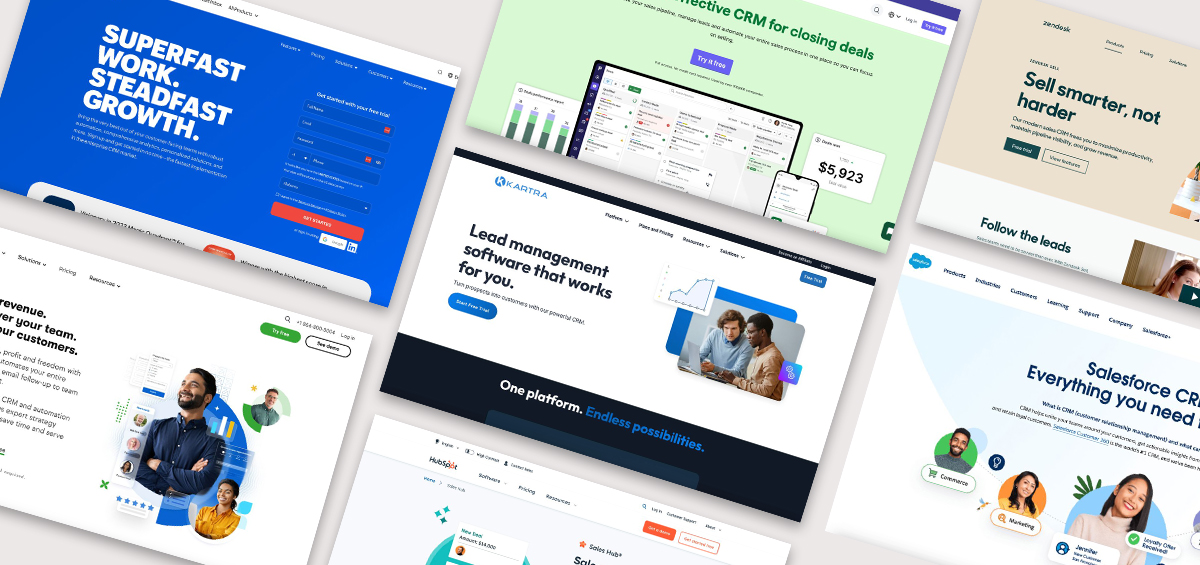Coaches, consultants, and all types of content creators stand to gain a lot from investing in search engine optimization (SEO). Showing up on the first page of Google for relevant searches is a long-term marketing strategy that drives brand awareness, builds trust with your followers, and leverages the largest source of website traffic that exists today! Read on to learn about why SEO is valuable for content creators and how it works.
What is Content SEO?
Content SEO is the practice of developing digital content that ranks well on search engine result pages (SERPs) for key terms. Content SEO encompasses both content strategy and actual content development, and it applies to all types of web pages — product pages, blog posts, landing pages, and more.
SEO draws attention to the role of search engines (especially Google) in getting content in front of users, but remember that creating content for search engines is never the goal. Content SEO — like any content creation — is for the benefit of your audience! Keep reading for details on how SEO works and what it means to create SEO-friendly content.
Content SEO vs. Technical SEO
Think of technical SEO as the behind-the-scenes strategies that improve your website’s performance. Technical SEO practices include improving page speed, developing meta descriptions, and fixing broken links. While subject matter experts and content creators can implement content SEO strategies themselves, technical SEO fixes are best accomplished by web developers.
Benefits of SEO for Content Creators
Many content creators use their website as a home base — somewhere people go to learn more about their brand after finding out about it from a different source (such as social media or a word-of-mouth referral). While this is an important use for certain website pages, it doesn’t leverage your website’s full potential. Optimizing your website for SEO offers some significant benefits.
SEO Boosts Brand Visibility
Even with the rising popularity of social media, Google is still the biggest driver of referral traffic by far. According to research conducted by Sparktoro, most websites get over 70% of their referral traffic from Google.
With millions of people searching for answers on Google every day, optimizing your website to be search engine friendly is an opportunity you can’t miss! SEO takes time and patience, but the return on investment is high — especially when you consider the costs of alternate marketing channels such as paid advertising. When a website is optimized to rank well in search engines, it becomes its own lead-generation tool.

Data source: research conducted by Sparktoro using Datos’ Clickstream Panel
SEO Brings in Targeted Traffic
One of the biggest difficulties when generating sales leads is controlling the quality of those leads. Brand visibility is most valuable when visitors align with your intended audience. Because the role of a search engine is to match online queries with highly relevant pages, this gives you a level of control over the types of visitors who discover your brand.
When the relevance of your website is clear to a search engine (and the user), you’ll be better positioned to appear in searches that reach the audience you want.
SEO Builds Long-Term Authority
Establishing trust with your audience is essential to sustainable brand growth. When your website consistently appears in relevant search results, you signal to your audience that you are an authority in your field and worth their attention.
And unlike a viral ad, for example, search engine optimization is a strategy with long-term benefits for your brand. When Google perceives that your website is highly valuable for users, there’s an increased likelihood of ranking well as you publish more pages with helpful content.
How SEO Works
Search engine software uses crawlers to index and rank website pages. The purpose of a search engine is simply to match an online search query with the best possible result — the one that will be most helpful to the user.
This means that writing content for a search engine is counterproductive. It’s also why keyword stuffing and other “black-hat” SEO tactics don’t work long-term — they don’t give users what they want.
Optimizing content for SEO isn’t about technical hacks or tricks for getting content to rank. It’s about making your website content as helpful as possible to your target audience. And remember that effective SEO content strategy is about the long game. It takes time to build authority in your industry and prove to people (and search engines) that you’re worth listening to!

There is no magic formula for getting content to rank, especially as search engine algorithms adapt and change over time. However, there are several fundamental SEO principles that will only help your content perform better:
1. Results are matched to specific questions
One of the most common SEO copywriting mistakes is trying to fit too much into one landing page or article. It’s tempting to want to share everything about a particular topic, but that isn’t how people consume information. And if it confuses the reader, it will confuse the search engine.
Each piece of content you publish online needs to answer a specific question. Not only will this be helpful to your reader, but it will show the search engine that your page is highly relevant for particular queries. If there’s more you want your reader to know, you can (and should) add strategic internal links to other website pages.
For example, if a fitness coach wants to publish an article on the best at-home workouts, it’s best if they don’t get sidetracked explaining the benefits of working out. They may have a lot of very helpful information on that subject, but it doesn’t answer the question! If the searcher feels that they’re not getting the information they wanted (and quickly), it will result in high bounce rates and low user satisfaction.
Short-tail vs. long-tail keywords
You may have heard the term “long-tail” keywords. “Long-tail” keywords are searches that involve more complex phrases and niche questions. For example, for a remote fitness coach, the phrase “best at-home workouts to build muscle” is a long-tail keyword with more relevance and specificity than a keyword like “best workouts”.
It’s often easier to rank for specific phrases and build authority in your space before moving on to generic keywords that get thousands of searches every day. But remember the key is targeting keywords that are hyper-relevant – not just specific. Pay attention to the questions you already get from your customers and write for those relevant topics first. Steer clear of overly long search phrases with low search volume.
2. The way people search their questions determines results
This may sound obvious at first glance, but it’s crucial to pause and think about how people search. As a subject matter expert, you have a particular way of thinking about and understanding your area of expertise. But the content you develop has to align with the way your audience thinks about — and searches for — your topic. This is the fundamental principle behind keyword research.
To rank well, your content should align with the common search phrases people use (keywords), and match the intent behind their search.
Want to learn more about how to find relevant search terms? Check out this guide from Ahrefs on how to do keyword research.
What is search intent?
There are two main categories of search intent: educational and commercial. Generally speaking, searchers are either looking for information or to buy a product or service. It’s crucial to identify the reason someone would be searching a particular phrase, so your content is as helpful and relevant to them as possible.
| Search Intent | Educational | Commercial |
|---|---|---|
| Types of search results | How-to guides, informational pages, topical blog posts, YouTube videos | Product category pages, brand landing pages, Google Shopping Feed listings, local landing pages |
| Keyword examples | “how to play guitar” “easy guitar chords” “is guitar easy to learn” | “guitar lessons” “learn guitar online” “guitar teacher near me” “beginner guitar” |
How do you determine search intent?
The simplest way to determine search intent is by analyzing search result pages for a keyword. The pages that currently rank for a search query tell you what Google currently finds to be the most relevant content.
For example, if the search results are full of pages with product listings, this tells you the search intent is likely commercial, not informational. Or, if most of the results are “how-to” guides, the searcher is likely looking for step-by-step instructions — a very practical type of educational content.
Pay particular attention to any featured snippets and the “people also ask” section on Google to identify important angles to cover or questions to answer to match searchers’ intent.
3. SEO content needs to be expert and original
Google frequently releases algorithm updates to improve the user experience and discourage low-quality content. To stay ahead of these updates (and the competition), focus your efforts on giving the best possible answer to the questions your target audience is searching.
Pay attention to the pages that currently rank well in organic search results so that you have an idea of what readers want you to cover. But don’t just copy what’s already out there. Consider how you can create more helpful content than what currently exists — both in terms of the content itself and how you present it.
Do you bring a unique angle to your subject? Do you offer readers a more engaging experience? You want to prove to your readers—and by extension Google—that your content is most worth paying attention to.
Google’s Content Quality Guidelines: E-E-A-T
Google has provided four criteria for evaluating content quality, abbreviated E-E-A-T. These aren’t exactly search engine ranking factors — think of them as guidelines for analyzing how helpful your content is on a broad level.
Experience – Do you as the author have first-hand experience about your subject?
Expertise – Along with experience, does your content show originality of thought and give your audience genuine expert insights?
Authority – Are you recognized in your industry? Why should a search engine or reader believe the information they read on your website?
Trustworthiness – Does your content help users, or is it spammy, malicious, or incorrect?
For more of Google’s recommendations, check out their guide to SEO fundamentals.
4. Readability contributes to content quality
Expert, in-depth information isn’t the only component of high-quality content. It also matters how easy the content is to consume.
One of the most important parts of readability is following a clear heading structure so your topic and major points are evident at a glance. From the title of your page to the CTA, each major section and its heading should follow a clear, purposeful outline. This makes it easy for your reader to understand your message, and easier for a search engine to know what’s on the page. You don’t have to sacrifice creativity, but remember each heading and subheading serves a very practical purpose in digital content.
Another way to improve the user experience is to incorporate engaging visual elements. Infographics, for instance, help break up long blocks of text and give the user something they can understand at a glance.
And even if you don’t incorporate graphics, it’s still a good idea to break long paragraphs into short, easy-to-read sections to prevent walls of text that are tiring to read.
Remember that people consume content differently — some people skim, others read every word. Your page should accommodate both types of readers so that no one has to work too hard to get the details they want.
How to use alt text
If your page incorporates visual elements like pictures or infographics, include an accurate description of the image known as “alt text”. Alt text shouldn’t be stuffed with keywords — it should simply describe the purpose of the image for the sake of accessibility to users who rely on screen readers. Alt text also helps search engines understand how the image relates to your piece of content.
5. Existing content should be regularly updated and improved
Working on content SEO doesn’t always mean developing new content! Once you have a collection of web pages, be sure to update any outdated or irrelevant pages, analyze performance metrics, and find opportunities for improvement. For example, if you have a page that ranks 8-20 on Google, this is a good indication that your page has relevant content that would drive even more search traffic with a few more optimizations. Google Search Console is a great tool to use at this stage.
As you dig into the performance metrics of older content, use this time to identify any content gaps. Are there valuable subjects that your competitors continually outrank you on? (Tools such as Ahrefs and SEMrush help with this analysis).
Do you have a lot of organic traffic but no conversions? (You may need to focus on bottom-of-funnel pages).
Search engine-optimized content takes time and effort, and you want to make sure that you spend your resources where they will have the biggest impact.
Avoid duplicate content
“Duplicate content” refers to pages on your site with overlapping content. These pages can compete with each other for the same target keywords, bringing down your rankings. Each page on your site, from blog articles to service pages, should have a distinct purpose and distinct content. As you update and add new content to your website, it’s important to keep track of what subjects you have already covered and to give each page its unique place on your website.
6. Good distribution helps content rank faster
Traffic to a page is one of the signals that a piece of content is valuable. If enough people are visiting that page and deriving value from it, the content gains authority. SEO content benefits from coordinated marketing channels that funnel interest surrounding your brand to pages on your website.
If you have a social media presence, for example, you can share some of that momentum with your website by steering followers to check out pages that are relevant to their interests. Email marketing is also a great source of referral traffic that can help your website gain more visibility.
And if you have the opportunity, acquiring quality backlinks (links from relevant websites) helps validate your authority on a particular subject and prove to a search engine that people find your website helpful.
How long does SEO take to see results?
As you might expect, it depends! Remember that SEO is a long-term digital marketing strategy that drives long-term results. SEO success is measured in terms of months and years, not days. You’ll discover what works best for your business through patience, consistency, and testing ideas. The good news is that you can start implementing SEO practices today and make improvements as you go.
SEO is about holistic business growth — establishing your brand as a trusted voice in your industry for years to come.
Create, Market, and Scale Your Online Business with Kartra
Kartra is the all in one platform that enables content creators and other entrepreneurs to successfully build online businesses. Find everything you need, all in one place — from a professional landing page builder to membership management software.


